Tech. sheet
- Manufacturer: Roland
- Model: VG-99
- Series: VG
- Category: Audio/MIDI Converters
- Other names:vg 99, vg99
We have no technical specifications for this product
but your help will be much welcomed
»
Videos
User reviews
4.6/5(9 reviews)
5
56 %
4
44 %
3
2
1
great interface
Published on 05/29/12 at 12:42The Roland VG 99 is a guitar system that was really appealing to me. Just the look of it seemed like it was something that I could really use. But before spending money on it I had a chance to really get into depth and use it for a while to see if it was something that I really would like. One of the key things that really made this unit stand out to me was just the overall functions of the unit. It seemed like Roland really put some time into making the VG 99. From its previous models there are many upgrades that they have made to make it quicker to do what you wanted.
UTILIZATION
It wasn’t easy for me to get started with this unit. I did have to open up the manual and spend a...…
UTILIZATION
It wasn’t easy for me to get started with this unit. I did have to open up the manual and spend a...…
Read more
The Roland VG 99 is a guitar system that was really appealing to me. Just the look of it seemed like it was something that I could really use. But before spending money on it I had a chance to really get into depth and use it for a while to see if it was something that I really would like. One of the key things that really made this unit stand out to me was just the overall functions of the unit. It seemed like Roland really put some time into making the VG 99. From its previous models there are many upgrades that they have made to make it quicker to do what you wanted.
UTILIZATION
It wasn’t easy for me to get started with this unit. I did have to open up the manual and spend a little time reading. But I did that from the start so I could eliminate the countless minutes I would spend doing trial and error. The manual was very easy to understand and it was clear and concise. After reading through the manual a little while I had the hang of it and was ready to get going.
GETTING STARTED
The sounds quality on the VG 99 is second to none, you really couldn’t ask for much more for this price. It supports USB connection to computers and also midi connections for other devices like other keybaords and modules or anything that can take midi connections. Connecting all of this stuff is very easy if you understand how midi works in comparison to different devices and sound.
OVERALL OPINION
Overall, Very pleased with the VG 99 the interface was a bit confusing at first but that was nothing that the manual couldn’t help me power through. You have the ability to really get some good sounds, and more importantly you can really get the sound you want with the Roland VG 99. The VG 99 really has taking my creativity to new levels.
UTILIZATION
It wasn’t easy for me to get started with this unit. I did have to open up the manual and spend a little time reading. But I did that from the start so I could eliminate the countless minutes I would spend doing trial and error. The manual was very easy to understand and it was clear and concise. After reading through the manual a little while I had the hang of it and was ready to get going.
GETTING STARTED
The sounds quality on the VG 99 is second to none, you really couldn’t ask for much more for this price. It supports USB connection to computers and also midi connections for other devices like other keybaords and modules or anything that can take midi connections. Connecting all of this stuff is very easy if you understand how midi works in comparison to different devices and sound.
OVERALL OPINION
Overall, Very pleased with the VG 99 the interface was a bit confusing at first but that was nothing that the manual couldn’t help me power through. You have the ability to really get some good sounds, and more importantly you can really get the sound you want with the Roland VG 99. The VG 99 really has taking my creativity to new levels.
See less
00
»
Published on 12/08/08 at 07:09
(Originally written by la.boulanderie/translated from Audiofanzine FR)
See Roland's website for detailed features and other user reviews.
However, I'll tell you something you won't find there:
The VG 99 is compatible with the GK2 I installed on my Ibanez 10 years ago, and which I didn't use a lot because the high latency of Midi guitars discouraged me. But this is a different story and it relates exclusively to the playing of the guitarist. I didn't try to burn my guitar like Jimi Hendrix but I think that's also possible. I tried to use the up/down buttons of the Midi pickup but had no success, and I think it has to do with wrong parameter editing on the VG.
The Midi pickup...…
See Roland's website for detailed features and other user reviews.
However, I'll tell you something you won't find there:
The VG 99 is compatible with the GK2 I installed on my Ibanez 10 years ago, and which I didn't use a lot because the high latency of Midi guitars discouraged me. But this is a different story and it relates exclusively to the playing of the guitarist. I didn't try to burn my guitar like Jimi Hendrix but I think that's also possible. I tried to use the up/down buttons of the Midi pickup but had no success, and I think it has to do with wrong parameter editing on the VG.
The Midi pickup...…
Read more
(Originally written by la.boulanderie/translated from Audiofanzine FR)
See Roland's website for detailed features and other user reviews.
However, I'll tell you something you won't find there:
The VG 99 is compatible with the GK2 I installed on my Ibanez 10 years ago, and which I didn't use a lot because the high latency of Midi guitars discouraged me. But this is a different story and it relates exclusively to the playing of the guitarist. I didn't try to burn my guitar like Jimi Hendrix but I think that's also possible. I tried to use the up/down buttons of the Midi pickup but had no success, and I think it has to do with wrong parameter editing on the VG.
The Midi pickup settings are a breeze. You only need a measuring tape if you don't know how much your guitar measures. Choose the pickup model. Enter the strings length and the distance between each string and the Midi pickup. Set the sensitivity according to your playing style and the balance between all chords. And you're ready to start playing (it takes five minutes). You can also make settings for several guitars.
The sound is accurate and clean because it's digital. It's not the right gear for you if you want noise, crackle, hiss and other vintage pleasures. On the contrary it's the perfect tool if you want perfect recordings.
For my part I expect the following results with such a device:
In the studio it must provide me a wide sound range without having to buy and service all corresponding instruments (folk guitar, classical guitar, dobro, banjo, sitar, mandolin, ukulele, Stratocaster, Telecaster, ES335, jazz hollowbody, Rickenbaker, Les paul, SG, 12-string acoustic and electric guitars, synth, bass... and more).
Live on stage it must allow me to mix several instruments at the same time (bass/guitar, folk/electric guitar, guitar/synth) and to create different sound ambiances for each song (we are only two musicians playing with a female singer).
UTILIZATION
Very easy to use. I bought it Friday morning and I already used it live on stage on Saturday night.
I did get a user's manual. I read it only to set up the Midi pickup. All other steps are very intuitive. I read it the day after our gig and I understood that I already knew everything I needed.
If you want to test all possibilities (which seem to be endless) you'll probably have to spend a lot time with it but it's certainly worth it. The editor software provided is also very easy to use.
I think the main difficulty is to understand all the possibilities in order to accurately edit it if you want to use all external controllers.
During our live gig I did use my electro-acoustic guitar because I didn't feel that comfortable with the system, but next time I will take the time to edit each sound according to the set list and I'll take only one guitar to the gig.
The ribbon controller and the D beam, which at first sight seem useless, can come in really handy in some stage situations.
GETTING STARTED
And what about the sound?
It's perfect for electric guitar and I can't really hear any difference compared to the original models (its actually unnerving that, given the authenticity of the sound, you actually think that you are playing with the pickups and you tend to try to use the guitar knobs which of course are useless).
The acoustic guitar sounds are really interesting. They can't replace a real acoustic guitar but they are still amazing. I didn't expect to be able to hear the sound of my fingers on the strings and to have the possibility to easily play pinch harmonics. The only thing I miss is the possibility to hit the top to get percussion effects (but perhaps it works if the Midi pickup is mounted on an acoustic guitar). Sitar and banjo sounds are great. My only complaint would be regarding the classical guitar, it has a strange response, more like a flamenco guitar than a classical guitar maybe?
But I think this upsetting feel has more to do with the playing technique than with the sound itself. When you play a folk guitar the position of your hand is different because the body is bigger. And the strings are heavier and thicker. Their vibration is different from the string vibration of a solid body guitar with a Midi pickup. If you can adapt your playing technique accordingly it ought to work perfectly. The sound of all 12-string guitars is perfect. And also the dobro sound.
The bass guitar simulations sound quite good.
I don't use a lot of synth presets but I'm sure you can get pretty good results with some editing.
What about effects? They are effective and well applied in the presets.
OVERALL OPINION
As a summary, I find this product amazing considering its price. I'm convinced that everybody will play such systems in the future and that our old magnetic guitar pickups will fall into oblivion.
I haven't tried the Midi and audio interface functions of the system. So I can't say anything about them.
Now I have a serious dilemma: either I definitely put away my Vigier (I like its wonderful neck, its weight and its color) and only play my old Ibanez via VG 99, or I buy another Midi pickup for my Vigier?
See Roland's website for detailed features and other user reviews.
However, I'll tell you something you won't find there:
The VG 99 is compatible with the GK2 I installed on my Ibanez 10 years ago, and which I didn't use a lot because the high latency of Midi guitars discouraged me. But this is a different story and it relates exclusively to the playing of the guitarist. I didn't try to burn my guitar like Jimi Hendrix but I think that's also possible. I tried to use the up/down buttons of the Midi pickup but had no success, and I think it has to do with wrong parameter editing on the VG.
The Midi pickup settings are a breeze. You only need a measuring tape if you don't know how much your guitar measures. Choose the pickup model. Enter the strings length and the distance between each string and the Midi pickup. Set the sensitivity according to your playing style and the balance between all chords. And you're ready to start playing (it takes five minutes). You can also make settings for several guitars.
The sound is accurate and clean because it's digital. It's not the right gear for you if you want noise, crackle, hiss and other vintage pleasures. On the contrary it's the perfect tool if you want perfect recordings.
For my part I expect the following results with such a device:
In the studio it must provide me a wide sound range without having to buy and service all corresponding instruments (folk guitar, classical guitar, dobro, banjo, sitar, mandolin, ukulele, Stratocaster, Telecaster, ES335, jazz hollowbody, Rickenbaker, Les paul, SG, 12-string acoustic and electric guitars, synth, bass... and more).
Live on stage it must allow me to mix several instruments at the same time (bass/guitar, folk/electric guitar, guitar/synth) and to create different sound ambiances for each song (we are only two musicians playing with a female singer).
UTILIZATION
Very easy to use. I bought it Friday morning and I already used it live on stage on Saturday night.
I did get a user's manual. I read it only to set up the Midi pickup. All other steps are very intuitive. I read it the day after our gig and I understood that I already knew everything I needed.
If you want to test all possibilities (which seem to be endless) you'll probably have to spend a lot time with it but it's certainly worth it. The editor software provided is also very easy to use.
I think the main difficulty is to understand all the possibilities in order to accurately edit it if you want to use all external controllers.
During our live gig I did use my electro-acoustic guitar because I didn't feel that comfortable with the system, but next time I will take the time to edit each sound according to the set list and I'll take only one guitar to the gig.
The ribbon controller and the D beam, which at first sight seem useless, can come in really handy in some stage situations.
GETTING STARTED
And what about the sound?
It's perfect for electric guitar and I can't really hear any difference compared to the original models (its actually unnerving that, given the authenticity of the sound, you actually think that you are playing with the pickups and you tend to try to use the guitar knobs which of course are useless).
The acoustic guitar sounds are really interesting. They can't replace a real acoustic guitar but they are still amazing. I didn't expect to be able to hear the sound of my fingers on the strings and to have the possibility to easily play pinch harmonics. The only thing I miss is the possibility to hit the top to get percussion effects (but perhaps it works if the Midi pickup is mounted on an acoustic guitar). Sitar and banjo sounds are great. My only complaint would be regarding the classical guitar, it has a strange response, more like a flamenco guitar than a classical guitar maybe?
But I think this upsetting feel has more to do with the playing technique than with the sound itself. When you play a folk guitar the position of your hand is different because the body is bigger. And the strings are heavier and thicker. Their vibration is different from the string vibration of a solid body guitar with a Midi pickup. If you can adapt your playing technique accordingly it ought to work perfectly. The sound of all 12-string guitars is perfect. And also the dobro sound.
The bass guitar simulations sound quite good.
I don't use a lot of synth presets but I'm sure you can get pretty good results with some editing.
What about effects? They are effective and well applied in the presets.
OVERALL OPINION
As a summary, I find this product amazing considering its price. I'm convinced that everybody will play such systems in the future and that our old magnetic guitar pickups will fall into oblivion.
I haven't tried the Midi and audio interface functions of the system. So I can't say anything about them.
Now I have a serious dilemma: either I definitely put away my Vigier (I like its wonderful neck, its weight and its color) and only play my old Ibanez via VG 99, or I buy another Midi pickup for my Vigier?
See less
00
»
Power, but gaps qqes
Published on 03/15/12 at 19:26 (This content has been automatically translated from French)Useless to return to the specifications. They are clearly listed on the official website ...
It may however be useful to recall that the VG-99 is a combination of several elements: a guitar modeler (Line 6 Variax way), a guitar synthesizer, an amp modeler, a multi-fx, a converter Guitar > MIDI audio interface on a USB port, a physical controller / MIDI.
Everything can be used with a conventional guitar, but it makes sense when it connects a guitar with a pickup kind GK3, GK2 or similar. Indeed, the use as "simple" multi-fx does nothing special, however, most other functions require a separate capture of each guitar string.
On paper, the VG-99 looks like being a condensed / Swiss...…
It may however be useful to recall that the VG-99 is a combination of several elements: a guitar modeler (Line 6 Variax way), a guitar synthesizer, an amp modeler, a multi-fx, a converter Guitar > MIDI audio interface on a USB port, a physical controller / MIDI.
Everything can be used with a conventional guitar, but it makes sense when it connects a guitar with a pickup kind GK3, GK2 or similar. Indeed, the use as "simple" multi-fx does nothing special, however, most other functions require a separate capture of each guitar string.
On paper, the VG-99 looks like being a condensed / Swiss...…
Read more
Useless to return to the specifications. They are clearly listed on the official website ...
It may however be useful to recall that the VG-99 is a combination of several elements: a guitar modeler (Line 6 Variax way), a guitar synthesizer, an amp modeler, a multi-fx, a converter Guitar > MIDI audio interface on a USB port, a physical controller / MIDI.
Everything can be used with a conventional guitar, but it makes sense when it connects a guitar with a pickup kind GK3, GK2 or similar. Indeed, the use as "simple" multi-fx does nothing special, however, most other functions require a separate capture of each guitar string.
On paper, the VG-99 looks like being a condensed / Swiss knife rather promising and exciting, but as often with Roland / Boss, and for several years in practice, we always end up wondering if the ingestion of the brand are really aware of what needed by musicians and in the end we almost always ends up with a bike to the basic concept but interesting to see botches incomplete development or incomplete. The VG-99 is fortunately not a fiasco, but it is unfortunately not the bottom of things.
UTILIZATION
The general configuration >>>>> Is it easy?
When we already know what type of machine, it is rather the infancy of art. However, for those who have never laid hands on this type of machine, getting started can be a little harder.
What is certain is that the MIDI conversion functions and the modeling results of guitar / synth require adjustment of the parameters of GK more accurate. GK parameters of which I speak concerns the optimization of the instrument used on the VG. These are briefly set the sensitivity of each string, positioning the pickup, the statement of the pitch (length of the vibrating strings for which simply measure the distance Nut-12th fret and then multiply by 2) of guitar used, etc.. This is indeed the sensitive point if you want to get the most out of the machine. We must act patiently, and most importantly, with logic and insight. Once that chore negotiated, one can enter the heart of the matter and start planning our first sounds. For this, as often, no hope little plants that sounds, if they can possibly help them understand the possibilities of the LV (provided you have a FC300 since the real-time controls are generally programmed function of this bracket), but beyond that, we should not expect results sound unbelievable. I think the best is to start from scratch by resetting a patch and the building from A to Z.
The front panel controls remain relatively clear and, for the basic functions, you do not spend three hours looking for the button that goes. However, a lot of "little things" could greatly improve the phases of programming. For example, a detail, but when m ^ m, the CHAIN menu that displays the chaining (order) effects it does not directly call the edit page of one or other known effects of requiring the user to first go through the main menu of this section. Tedious when a button could simply allow calling this page since the chaining.
I know, I'm pinailleur, but my experience RolBoss products makes me think that at one time, the ingestion of the brand knew to think about all these details because the older machines often swarm of little things like that.
M ^ m of the way, one can appreciate the CATEGORY function is also present in many multi-fx brand, but in the m ^ m time, regret that this function does not allow the classification of a preset m ^ m in more than one of these categories. This is particularly unfortunate that the AG offers both conventional guitar sounds AND synth which can quickly bring a preset to be useful both in Funk Rock, or even cause it to be classified as in the category that Synth Lead Dubbing ...
Well, it does not alter the content of the machine, but given its relative complexity, it is typically the kind of thing that makes the difference with the competition. Now this is where the problem lies. Competition, RolBoss knows she does not really. Under these conditions, it is unclear what might encourage them to leave the ends of the digital foundation to innovate a little more. Those who know the series loopstation and know what the competition has in the past 20 years fully understand what I mean. But anyway, this is not the topic here ...
GETTING STARTED
The format desk is not the most suitable for use on stage. I would have preferred a real pedalboard or rack size, but there is a little bastard and it did not m ^ m the advantage of being better suited to use studio / home studio since the machine remains relatively bulky on a desk. The tripod is an optional foutage mouth of both financial stability. A simple sheet metal panel does a better job for much less.
In short, we can ask the question this choice, but after all, why not ...
The manual is rather didactic, but unfortunately it lacks technical info <;
OVERALL OPINION
The sound quality is to consider first. Indeed, it is clear that the versatility of the LV is a separate tool, it can however be quite critical of the basic functions that together. Thus, in terms of modeling guitar, I must admit that I m ^ m from the world Variax, I'm much happier with the VG99. I regret, however, again, some shortcomings.
1 ° The choice of modeled guitars is finally facing a very weak
Variax which offers much more. But is the quality over quantity.
2 ° The model VARI is the only model fully "customizable" shows some limitations ordnance by the Variax. Impossible, for example, to make a personal model in HSS config. Only two virtual microphones can be used. M ^ m in the vein, the choice of microphones is proving very stingy. Otherwise, we would have appreciated being able to customize a little rendering of each microphone.
3 ° acoustic side, again missing a few things that the model does not come close VARI.
Side multi-fx:
The intrinsic quality of the rest of Boss effects. We like it or not. THE problem is that m ^ m if you like the sound Boss, it is clear that certain effects, the VG99 is worse than its predecessors. I think of the reverb-starved life. Delays that do not m ^ m possibilities than a GT-Pro is more powerful in this respect. Some modulations also lack their targets. The Univibe example that seems softer on the GT-Pro. The phaser that lacks teeth but more importantly, quickly turns to vinegar in extreme settings. The chorus always typed 80's and, especially, always adding the invariable level without busting eardrums bearing means really the problem.
Side amp modeling:
Ink and COSM technology always dear to the brand and, unfortunately, still shows all its limits. If, in competition, it is often easy to get good sound, with RolBoss is still the problem m ^ m: Be very careful in setting sessions. A sound will indeed quickly turn to mush if we take notice. In the end, only experience will provide satisfactory sound. And when we find one, the challenge is not to lose it! on the other hand, when it is found that sound, then here you can quickly reach heights of enjoyment. It is certainly very far from the high-ranges like the Axe-FX, however, there is already enough to have fun.
Remains that the AG has a sound combination of power unattainable in competition without going through the combination of several machines. The all-in-One LV, if he has limits, also justifies the pleasure one derives. I'm pretty happy with this machine m ^ m if I really regret that RolBoss falls asleep so deeply on his laurels.
It may however be useful to recall that the VG-99 is a combination of several elements: a guitar modeler (Line 6 Variax way), a guitar synthesizer, an amp modeler, a multi-fx, a converter Guitar > MIDI audio interface on a USB port, a physical controller / MIDI.
Everything can be used with a conventional guitar, but it makes sense when it connects a guitar with a pickup kind GK3, GK2 or similar. Indeed, the use as "simple" multi-fx does nothing special, however, most other functions require a separate capture of each guitar string.
On paper, the VG-99 looks like being a condensed / Swiss knife rather promising and exciting, but as often with Roland / Boss, and for several years in practice, we always end up wondering if the ingestion of the brand are really aware of what needed by musicians and in the end we almost always ends up with a bike to the basic concept but interesting to see botches incomplete development or incomplete. The VG-99 is fortunately not a fiasco, but it is unfortunately not the bottom of things.
UTILIZATION
The general configuration >>>>> Is it easy?
When we already know what type of machine, it is rather the infancy of art. However, for those who have never laid hands on this type of machine, getting started can be a little harder.
What is certain is that the MIDI conversion functions and the modeling results of guitar / synth require adjustment of the parameters of GK more accurate. GK parameters of which I speak concerns the optimization of the instrument used on the VG. These are briefly set the sensitivity of each string, positioning the pickup, the statement of the pitch (length of the vibrating strings for which simply measure the distance Nut-12th fret and then multiply by 2) of guitar used, etc.. This is indeed the sensitive point if you want to get the most out of the machine. We must act patiently, and most importantly, with logic and insight. Once that chore negotiated, one can enter the heart of the matter and start planning our first sounds. For this, as often, no hope little plants that sounds, if they can possibly help them understand the possibilities of the LV (provided you have a FC300 since the real-time controls are generally programmed function of this bracket), but beyond that, we should not expect results sound unbelievable. I think the best is to start from scratch by resetting a patch and the building from A to Z.
The front panel controls remain relatively clear and, for the basic functions, you do not spend three hours looking for the button that goes. However, a lot of "little things" could greatly improve the phases of programming. For example, a detail, but when m ^ m, the CHAIN menu that displays the chaining (order) effects it does not directly call the edit page of one or other known effects of requiring the user to first go through the main menu of this section. Tedious when a button could simply allow calling this page since the chaining.
I know, I'm pinailleur, but my experience RolBoss products makes me think that at one time, the ingestion of the brand knew to think about all these details because the older machines often swarm of little things like that.
M ^ m of the way, one can appreciate the CATEGORY function is also present in many multi-fx brand, but in the m ^ m time, regret that this function does not allow the classification of a preset m ^ m in more than one of these categories. This is particularly unfortunate that the AG offers both conventional guitar sounds AND synth which can quickly bring a preset to be useful both in Funk Rock, or even cause it to be classified as in the category that Synth Lead Dubbing ...
Well, it does not alter the content of the machine, but given its relative complexity, it is typically the kind of thing that makes the difference with the competition. Now this is where the problem lies. Competition, RolBoss knows she does not really. Under these conditions, it is unclear what might encourage them to leave the ends of the digital foundation to innovate a little more. Those who know the series loopstation and know what the competition has in the past 20 years fully understand what I mean. But anyway, this is not the topic here ...
GETTING STARTED
The format desk is not the most suitable for use on stage. I would have preferred a real pedalboard or rack size, but there is a little bastard and it did not m ^ m the advantage of being better suited to use studio / home studio since the machine remains relatively bulky on a desk. The tripod is an optional foutage mouth of both financial stability. A simple sheet metal panel does a better job for much less.
In short, we can ask the question this choice, but after all, why not ...
The manual is rather didactic, but unfortunately it lacks technical info <;
OVERALL OPINION
The sound quality is to consider first. Indeed, it is clear that the versatility of the LV is a separate tool, it can however be quite critical of the basic functions that together. Thus, in terms of modeling guitar, I must admit that I m ^ m from the world Variax, I'm much happier with the VG99. I regret, however, again, some shortcomings.
1 ° The choice of modeled guitars is finally facing a very weak
Variax which offers much more. But is the quality over quantity.
2 ° The model VARI is the only model fully "customizable" shows some limitations ordnance by the Variax. Impossible, for example, to make a personal model in HSS config. Only two virtual microphones can be used. M ^ m in the vein, the choice of microphones is proving very stingy. Otherwise, we would have appreciated being able to customize a little rendering of each microphone.
3 ° acoustic side, again missing a few things that the model does not come close VARI.
Side multi-fx:
The intrinsic quality of the rest of Boss effects. We like it or not. THE problem is that m ^ m if you like the sound Boss, it is clear that certain effects, the VG99 is worse than its predecessors. I think of the reverb-starved life. Delays that do not m ^ m possibilities than a GT-Pro is more powerful in this respect. Some modulations also lack their targets. The Univibe example that seems softer on the GT-Pro. The phaser that lacks teeth but more importantly, quickly turns to vinegar in extreme settings. The chorus always typed 80's and, especially, always adding the invariable level without busting eardrums bearing means really the problem.
Side amp modeling:
Ink and COSM technology always dear to the brand and, unfortunately, still shows all its limits. If, in competition, it is often easy to get good sound, with RolBoss is still the problem m ^ m: Be very careful in setting sessions. A sound will indeed quickly turn to mush if we take notice. In the end, only experience will provide satisfactory sound. And when we find one, the challenge is not to lose it! on the other hand, when it is found that sound, then here you can quickly reach heights of enjoyment. It is certainly very far from the high-ranges like the Axe-FX, however, there is already enough to have fun.
Remains that the AG has a sound combination of power unattainable in competition without going through the combination of several machines. The all-in-One LV, if he has limits, also justifies the pleasure one derives. I'm pretty happy with this machine m ^ m if I really regret that RolBoss falls asleep so deeply on his laurels.
See less
250
»
Published on 04/24/08 at 09:03 (This content has been automatically translated from French)
Multi-effects, amp simulator, guitar (electric, acoustic, bass) synth with a midi interface.
The VG99 contains the equivalent of two-level systems of the GT-Pro (COSM include two GT-Pro).
Applied COSM effects and amp simulations / guitar / synth.
Effects / simulations can be edited through an editor via a USB connection.
The same connection can record 24 bit 44 khz. VG99 librarian software is supplied to manage the effects and presets created.
Front panel connectors:
_ Sensor input GK3
_ Controllers:
_ A ribbon controller that is used by sliding his finger on it (hard plastic)
_ D Beam detects the passage of an object (neck of the guitar) above the sensor can be used to...…
The VG99 contains the equivalent of two-level systems of the GT-Pro (COSM include two GT-Pro).
Applied COSM effects and amp simulations / guitar / synth.
Effects / simulations can be edited through an editor via a USB connection.
The same connection can record 24 bit 44 khz. VG99 librarian software is supplied to manage the effects and presets created.
Front panel connectors:
_ Sensor input GK3
_ Controllers:
_ A ribbon controller that is used by sliding his finger on it (hard plastic)
_ D Beam detects the passage of an object (neck of the guitar) above the sensor can be used to...…
Read more
Multi-effects, amp simulator, guitar (electric, acoustic, bass) synth with a midi interface.
The VG99 contains the equivalent of two-level systems of the GT-Pro (COSM include two GT-Pro).
Applied COSM effects and amp simulations / guitar / synth.
Effects / simulations can be edited through an editor via a USB connection.
The same connection can record 24 bit 44 khz. VG99 librarian software is supplied to manage the effects and presets created.
Front panel connectors:
_ Sensor input GK3
_ Controllers:
_ A ribbon controller that is used by sliding his finger on it (hard plastic)
_ D Beam detects the passage of an object (neck of the guitar) above the sensor can be used to change the preset switch between two guitars ... .. change effects .. etc. ..
Rear panel connectors:
in order from left to right
_ A guitar input jack
_ A guitar output jack (its unmodified guitar)
_ 2 outputs L / R XLR
_ 2 outputs Unbalanced jack L / R
_ 1 x headphone / phono
_ 1 digital output (SPDIF)
_ An input jack for an expression pedal EV5 (recommended)
_ An input jack for a footswitch Boss FS-6 (recommended)
_ 1 x USB
_ 1 x RJ45 to connect the FC-300 MIDI foot controller with the supplied cable (do not connect to an ethernet network)
_ MIDI IN and OUT
_ A power input ... there is a small external transformer
The unit is rack vertically using spacers as an option.
It is possible to fix on a horizontal support on one foot.
The unit comes with a USB cable, a cable connection at GK3 (the GK3 must be purchased separately) a cable connection to the pedal FC-300, 4 wheel to screw the unit on the braces rack.
A manual in English, a CD-ROM containing the driver and two USB interfaces for machine management (modeling and library)
We regret the absence of:
_ A manual in French
Video presentation here:
https://www.rolandus.com/products/productdetails.aspx?ObjectId=849&skip=true&page=video
UTILIZATION
The manual is in English ... the operating system of the machine also .. no localization possible.
The firmware updates are possible by transfer of MIDI files (see the forum).
Editing is easy, depending on what you want to do it will read the manual ...
People who have had a GT6/GT8 gather the large data wheel to change the preset.
400 200 user preset banks (editable) and 200 system.
We recall the screens with buttons ... then each screen has several pages that you scroll with the arrow keys. It changes the settings for the buttons in front below the screen.
I return to the aesthetics of the machine. I was unpleasantly surprised by the screen made of white squares on a black background. I expected a better definition more in line with the quality of the software interface. So the definition of the screen is rough ... but to use it proves very comfortable ... the inclined plane longer large print can work at 1 meter from the camera without blinking.
Still on the aesthetic disappointment because the case is not the same metal as the GT6 and GT8. The bottom is plastic and it looks like plastic but cold like metal alloy appears to be fairly soft. Touch is graphite and enjoyable. Fragile ... so be careful ... this model is not built like a tank.
It will be appreciated that D-Beam allows you to change preset guitar effects .. last of all what we want just by passing the sleeve over the sensor. The ribbon control is more controversial ... made of hard plastic it works great and allows the control of modulation / pitch etc ... but how to play guitar at the same time make a wha with a finger? It may help in the studio.
We connect the guitar with the cable in the GK3 facade in the device ... the guitar signal itself returning in GK3. We can use the GK3 at leisure, or the guitar signal or a mix of both.
The GK3 has a knob for volume control that can be assigned to the control of another parameter, two buttons for variations within a preset (state) and finally a switch signal GK3/signal guitar / mix of both .
The GK3 is provided with means for mounting the sensor range. The GK3 in itself damaging to place it on the guitar strap attachment: _ it has a metal face fabric / foam to protect the guitar.
The sensor can be placed on a support screwed into the guitar. This support can be mounted on an easel type gibson (without degradation for the guitar). The sensor can also be bonded through double-sided adhesive on the guitar. Shims are provided to adjust the space between the strings and capteur.J 'I chose the latter non-destructive editing for the guitar and it fits comfortably.
The MIDI standard is accessible via the USB or the MIDI output. We can therefore dispense with a Midi interface for the PC.
The system works very well with cubase, ableton wrong with the steering ... magix VST is immediately noticeable.
I lowered my rating because of the problem of locating the device.
The build quality shocked me the first day I expected to find a way tank construction and WP6 knob (on stage attention must be paid) for at ... As I discovered the qualities of this I found the camera ... smile and good ergonomics of the whole I am satisfied.
GETTING STARTED
The models made by the GK3 are excellent, more loyal than those provided by a Variax. One stratum to the tone and dynamics of a stratum, ditto for TV etc ... The acoustic guitars are successful. Everything is tweakable.
The open tuning can be used. It is possible to program an acoustic sound on a string, an electric sound on the next string, open Tune all, to ask the VG99 to turn all this into 12 strings ... and open each independently Tune twelve strings of the chord associated .... phew (pretty basic after all, o)).
I do not put the maximum to take into account the opinion of some people who do not like the GT-Pro. For the treatment of bare sound of the guitar, the sound of the GT-Pro. For the models against the GK3 deserve full marks because I know nothing about that for now ... equal Fender Roland has not chosen for its VGcaster for nothing.
See the first samples provided here:
http://www.soundclick.com/bands/pagemusic.cfm?bandID=741002
Here with more talent and time, there are some VST appears:
_the samples "directly out of the box" are not very good, outstanding sensor hack with Cubase LE which does not generate the mp3. The last two samples 7 & 8 give a better quality recording (sensor set and I used another sequencer that generates mp3 320kb / s) ... there is a loss of momentum, however, probably due to streaming or upload to the server from the original mp3. I would do the samples in the same quality slowly ... other samples are coming according to my whims. O)
OVERALL OPINION
I am personally very satisfied with the models offered and in fact I use more than that ... I have not wanted to use it for the functions of the GT-Pro (I look at my beautiful guitar gathering dust ).
I came back on the scoring on 12 string and I am definitely on the c. ..
Patch 66 that simulates two twelve strings are to die for.
I do not understand how this type of equipment does not know more success.
The quality of the simulations is staggering (to eat the headphones AKG 271), the genius of Roland and the idea of having two processors for two guitars. Except that opening the door combinations which prove to be far from the gadget (the low E string and electric guitar for the others) as Roland stated in its manual it is recommended that a time one defined a model of guitar / amp to double it by adding the second a slight delay. It works fantastically well and we gain in realism and dynamic ...
I put the maximum .. this product is really ... to discover the GK3.
(Incidentally, I did not know of any product, or want to spend the GT8 Pro, I'm leaning towards this product which brought together such a GT-Pro and features MIDI. I did not pay attention to the modeling side. .. and yet it is this aspect of the machine that wins because of its unsurpassed quality now. Who uses this system? Well, I think a lot of professional background in the studio, but discreetly apart .... Bertignac came to play a song with a Gibson SG400 taratata equipped with GK3 and obviously the distortion was not from the guitar)
Finally I'm here and still available for more detailed information.
The VG99 contains the equivalent of two-level systems of the GT-Pro (COSM include two GT-Pro).
Applied COSM effects and amp simulations / guitar / synth.
Effects / simulations can be edited through an editor via a USB connection.
The same connection can record 24 bit 44 khz. VG99 librarian software is supplied to manage the effects and presets created.
Front panel connectors:
_ Sensor input GK3
_ Controllers:
_ A ribbon controller that is used by sliding his finger on it (hard plastic)
_ D Beam detects the passage of an object (neck of the guitar) above the sensor can be used to change the preset switch between two guitars ... .. change effects .. etc. ..
Rear panel connectors:
in order from left to right
_ A guitar input jack
_ A guitar output jack (its unmodified guitar)
_ 2 outputs L / R XLR
_ 2 outputs Unbalanced jack L / R
_ 1 x headphone / phono
_ 1 digital output (SPDIF)
_ An input jack for an expression pedal EV5 (recommended)
_ An input jack for a footswitch Boss FS-6 (recommended)
_ 1 x USB
_ 1 x RJ45 to connect the FC-300 MIDI foot controller with the supplied cable (do not connect to an ethernet network)
_ MIDI IN and OUT
_ A power input ... there is a small external transformer
The unit is rack vertically using spacers as an option.
It is possible to fix on a horizontal support on one foot.
The unit comes with a USB cable, a cable connection at GK3 (the GK3 must be purchased separately) a cable connection to the pedal FC-300, 4 wheel to screw the unit on the braces rack.
A manual in English, a CD-ROM containing the driver and two USB interfaces for machine management (modeling and library)
We regret the absence of:
_ A manual in French
Video presentation here:
https://www.rolandus.com/products/productdetails.aspx?ObjectId=849&skip=true&page=video
UTILIZATION
The manual is in English ... the operating system of the machine also .. no localization possible.
The firmware updates are possible by transfer of MIDI files (see the forum).
Editing is easy, depending on what you want to do it will read the manual ...
People who have had a GT6/GT8 gather the large data wheel to change the preset.
400 200 user preset banks (editable) and 200 system.
We recall the screens with buttons ... then each screen has several pages that you scroll with the arrow keys. It changes the settings for the buttons in front below the screen.
I return to the aesthetics of the machine. I was unpleasantly surprised by the screen made of white squares on a black background. I expected a better definition more in line with the quality of the software interface. So the definition of the screen is rough ... but to use it proves very comfortable ... the inclined plane longer large print can work at 1 meter from the camera without blinking.
Still on the aesthetic disappointment because the case is not the same metal as the GT6 and GT8. The bottom is plastic and it looks like plastic but cold like metal alloy appears to be fairly soft. Touch is graphite and enjoyable. Fragile ... so be careful ... this model is not built like a tank.
It will be appreciated that D-Beam allows you to change preset guitar effects .. last of all what we want just by passing the sleeve over the sensor. The ribbon control is more controversial ... made of hard plastic it works great and allows the control of modulation / pitch etc ... but how to play guitar at the same time make a wha with a finger? It may help in the studio.
We connect the guitar with the cable in the GK3 facade in the device ... the guitar signal itself returning in GK3. We can use the GK3 at leisure, or the guitar signal or a mix of both.
The GK3 has a knob for volume control that can be assigned to the control of another parameter, two buttons for variations within a preset (state) and finally a switch signal GK3/signal guitar / mix of both .
The GK3 is provided with means for mounting the sensor range. The GK3 in itself damaging to place it on the guitar strap attachment: _ it has a metal face fabric / foam to protect the guitar.
The sensor can be placed on a support screwed into the guitar. This support can be mounted on an easel type gibson (without degradation for the guitar). The sensor can also be bonded through double-sided adhesive on the guitar. Shims are provided to adjust the space between the strings and capteur.J 'I chose the latter non-destructive editing for the guitar and it fits comfortably.
The MIDI standard is accessible via the USB or the MIDI output. We can therefore dispense with a Midi interface for the PC.
The system works very well with cubase, ableton wrong with the steering ... magix VST is immediately noticeable.
I lowered my rating because of the problem of locating the device.
The build quality shocked me the first day I expected to find a way tank construction and WP6 knob (on stage attention must be paid) for at ... As I discovered the qualities of this I found the camera ... smile and good ergonomics of the whole I am satisfied.
GETTING STARTED
The models made by the GK3 are excellent, more loyal than those provided by a Variax. One stratum to the tone and dynamics of a stratum, ditto for TV etc ... The acoustic guitars are successful. Everything is tweakable.
The open tuning can be used. It is possible to program an acoustic sound on a string, an electric sound on the next string, open Tune all, to ask the VG99 to turn all this into 12 strings ... and open each independently Tune twelve strings of the chord associated .... phew (pretty basic after all, o)).
I do not put the maximum to take into account the opinion of some people who do not like the GT-Pro. For the treatment of bare sound of the guitar, the sound of the GT-Pro. For the models against the GK3 deserve full marks because I know nothing about that for now ... equal Fender Roland has not chosen for its VGcaster for nothing.
See the first samples provided here:
http://www.soundclick.com/bands/pagemusic.cfm?bandID=741002
Here with more talent and time, there are some VST appears:
_the samples "directly out of the box" are not very good, outstanding sensor hack with Cubase LE which does not generate the mp3. The last two samples 7 & 8 give a better quality recording (sensor set and I used another sequencer that generates mp3 320kb / s) ... there is a loss of momentum, however, probably due to streaming or upload to the server from the original mp3. I would do the samples in the same quality slowly ... other samples are coming according to my whims. O)
OVERALL OPINION
I am personally very satisfied with the models offered and in fact I use more than that ... I have not wanted to use it for the functions of the GT-Pro (I look at my beautiful guitar gathering dust ).
I came back on the scoring on 12 string and I am definitely on the c. ..
Patch 66 that simulates two twelve strings are to die for.
I do not understand how this type of equipment does not know more success.
The quality of the simulations is staggering (to eat the headphones AKG 271), the genius of Roland and the idea of having two processors for two guitars. Except that opening the door combinations which prove to be far from the gadget (the low E string and electric guitar for the others) as Roland stated in its manual it is recommended that a time one defined a model of guitar / amp to double it by adding the second a slight delay. It works fantastically well and we gain in realism and dynamic ...
I put the maximum .. this product is really ... to discover the GK3.
(Incidentally, I did not know of any product, or want to spend the GT8 Pro, I'm leaning towards this product which brought together such a GT-Pro and features MIDI. I did not pay attention to the modeling side. .. and yet it is this aspect of the machine that wins because of its unsurpassed quality now. Who uses this system? Well, I think a lot of professional background in the studio, but discreetly apart .... Bertignac came to play a song with a Gibson SG400 taratata equipped with GK3 and obviously the distortion was not from the guitar)
Finally I'm here and still available for more detailed information.
See less
20
»
Audio excerpts
-
00:0000:27

-
00:0001:00

-
00:0001:00

Manuals and other files
Other Roland audio/MIDI Converters
-
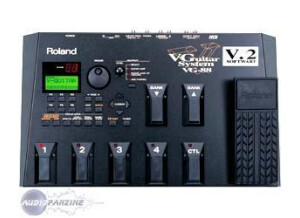
VG-88 VGuitar V2
Audio/MIDI Converter
-
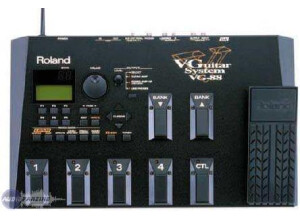
VG-88 VGuitar
Audio/MIDI Converter
-
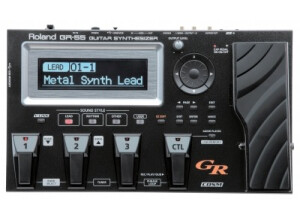
GR-55GK
Audio/MIDI Converter
$866 new (1 offer) -
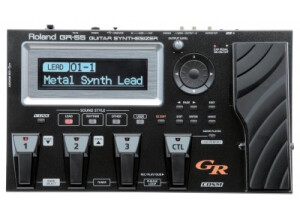
GR-55S
Audio/MIDI Converter
$782 new (2 offers) -
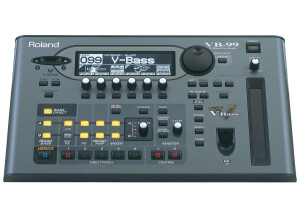
VB-99
Audio/MIDI Converter
-
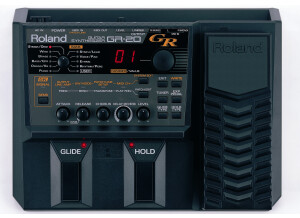
GR-20
Audio/MIDI Converter
-
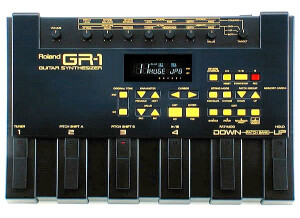
GR-1 Guitar Synthesizer
Audio/MIDI Converter
-
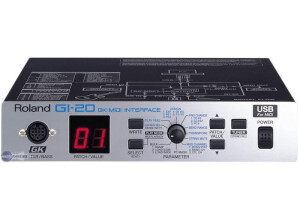
GI-20
Audio/MIDI Converter
-
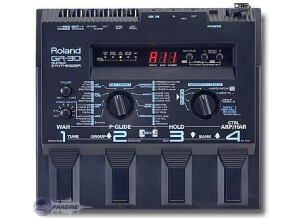
GR-30
Audio/MIDI Converter
-
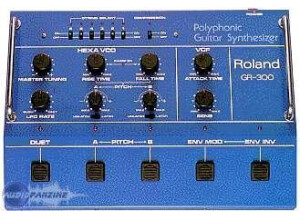
GR-300
Audio/MIDI Converter














